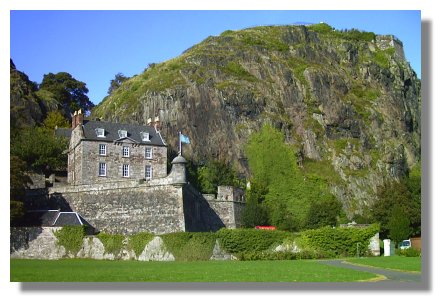

My Paternal Grandmother's Father, William Colquhoun Paxton was born 27 August 1868 in Saint Andrew Parish, Edinburgh, Scotland. He was of the Colquhoun (pronounced "ca-hoon" with the accent on the second syllable) Clan of Scotland.
As a member of a Clan, one is entitled to wear the Crest of the Clan Chief as a "Badge." The crest must be surrounded by a belt or "Garter". On this belt is written the motto of the Clan. In the case of Clan Colquhoun, the motto is "Si Je Puis" which is translated as "If I Can". The crest of Colquhoun is a Hart's head. The badge should bear the Gaelic phrase "An Cirean Ceann Cinnidh." This is closely translated as "The Crest of the Clan Chief." This will indicate that you are a member of the Clan and that you are not claiming the crest as "yours", but that the right to display it is granted by your membership in the clan.

The story behind the clan motto, "Si Je Puis" goes like this... Sir John Colquhoun 10th of Luss was issued a command by King James I to seize the well-fortified Dumbarton Castle from the "too powerful" Lennox family in 1424. Sir John replied in the Norman-French fashionable at Court at that date, "Si Je Puis" (If I Can). The Chief gathered a group of men close to him and hid them in the woods outside of Dumbarton's gates. Then he lured a red hart (stag) by the gates chased by two greyhounds. The starving garrison in the castle opened the gates to chase the stag, whereupon the chiefs clansmen rushed the castle and captured it for the King. One of the most unusual details passed down with this story is that the Chief captured the castle without killing anyone which is remarkable not only for that time but for now, as well.

The Colquhoun Tartan is a Blue (Balmoral) and Green plaid with Black, Red and White (Wilsons) accents. Colquhoun is Mac a' Chombaich (Nic a' Chombaich for a female) in Gaelic. In the USA the name is often found as Calhoun. Surnames regarded as septs (sub-branch) of the Colquhoun clan include Cowan, Ingram, King, MacCowan and MacManus.

The Clan seat of Rossdhu House, is on the banks of Loch Lomond. The name Colquhoun comes from the Gaelic place name "cuil cumhann" meaning "narrow corner". The location of Colquhoun is on the western shores of Loch Lomond. Umfphredus de Kilpatrick was granted the lands by the Earl of Lennox in the 13th century, during the reign of King Alexander II. He adopted the surname from the name of the area. Initially, he lived at Dunglas castle, which was not far from the royal Dumbarton Castle. Later, the Colquhouns became the keepers of that castle. In 1368 Sir Robert Colquhoun married the fair Maid of Luss, heiress to nearby lands in Glen Luss and since then the clan name has properly been - Colquhoun of Luss. The vast Colquhoun estates were inherited in 1718 by a new Fair Maid of Luss, Anne Colquhoun. The 11th Laird of Luss was made a Baronet of Nova Scotia in 1625. Sir James Grant Colquhoun, succeeded to the estates and built a mansion at Rossdhu on the site of the ruins of Rossdhu Castle. Rossdhu is in a sense therefore more than a stately country house hard by an historic castle's ruins in one of the best-known and most beautiful settings in the world. It is above all the official home of the head of a world-wide family group: the whole of the Clan Colquhoun.